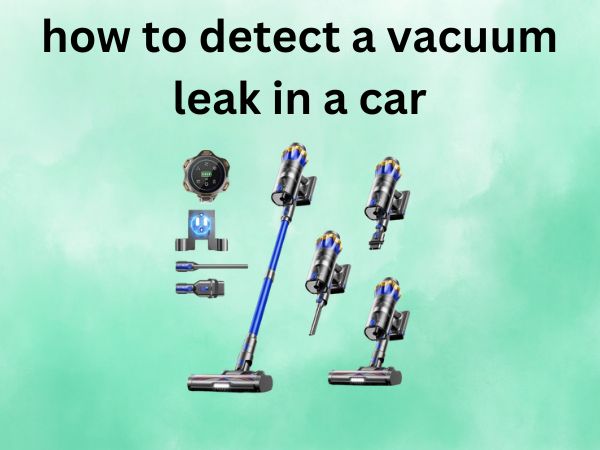How to Detect a Vacuum Leak in a Car [A Complete DIY Guide]
Ever wondered why your car suddenly started acting like a moody teenager? One day it’s purring like a content cat, and the next it’s rough idling, hesitating during acceleration, or mysteriously burning through gas faster than a Formula 1 race car. If you’re nodding your head right now, you might be dealing with a vacuum leak – one of the most common yet frustrating automotive problems that can turn your smooth ride into a mechanical nightmare.
Don’t worry, though. You don’t need to be a certified mechanic or own a garage full of expensive tools to track down these sneaky culprits. With the right knowledge and a few simple techniques, you can become a vacuum leak detective and get your car back to its happy, efficient self.
Table of Contents
What Is a Vacuum Leak and Why Should You Care?
Picture your car’s engine as a sophisticated breathing system. Just like your lungs need the right amount of air to function properly, your engine relies on a precise mixture of air and fuel to run smoothly. A vacuum leak is essentially an unwanted breath of air sneaking into this carefully balanced system, throwing everything out of whack.
Understanding Your Car’s Vacuum System
Your car’s vacuum system is like the nervous system of your engine – it’s everywhere, controlling everything from your power brakes to emission controls. The engine creates vacuum pressure during the intake stroke, and this vacuum is harnessed to operate various components throughout your vehicle.
Think of it this way: if your engine’s intake system were a straw, a vacuum leak would be like having tiny holes poked in that straw. You’d have to suck much harder to get the same amount of liquid, and the whole drinking experience would be frustrating and inefficient. That’s exactly what happens to your engine when vacuum leaks occur.
The Silent Saboteur: How Vacuum Leaks Affect Performance
Vacuum leaks are sneaky troublemakers that can cause a cascade of problems. When excess air enters your engine’s intake system, it creates a lean air-fuel mixture. Your engine’s computer tries to compensate, but it’s like trying to tune a guitar with a broken string – you might get close, but it’ll never sound quite right.
This imbalance leads to poor fuel economy, rough idling, reduced power, and increased emissions. In severe cases, it can even cause engine damage if left untreated. The frustrating part? These symptoms often develop gradually, making them easy to dismiss as “normal aging” until they become impossible to ignore.
Tell-Tale Signs Your Car Has a Vacuum Leak
Recognizing vacuum leak symptoms is like learning to read your car’s body language. Once you know what to look for, these signs become as obvious as a neon billboard on a dark highway.
Engine Performance Red Flags
The most common symptom is rough idling – your engine might shake, vibrate, or sound like it’s running on three cylinders instead of four. You might also notice hesitation during acceleration, as if your car is thinking twice before responding to your gas pedal inputs.
Your fuel economy might take a nosedive too. If you’re suddenly making more frequent trips to the gas station without changing your driving habits, a vacuum leak could be the culprit. It’s like having a hole in your wallet – money (or in this case, fuel) just disappears faster than it should.
Audible Clues That Scream “Vacuum Leak!”
Listen carefully to your engine – vacuum leaks often announce themselves with a distinctive hissing or whistling sound, especially at idle. It’s similar to the sound of air escaping from a tire, but more subtle and coming from under your hood.
This hissing might be more noticeable when the engine is cold or when you’re accelerating. Sometimes, you might hear a clicking or tapping sound as well, particularly if the leak is affecting your engine’s timing or valve operation.
Dashboard Warning Lights You Shouldn’t Ignore
Your car’s computer is pretty smart, and it’ll often detect the problems caused by vacuum leaks before you do. The check engine light is the most common warning, but you might also see lights related to emissions, engine performance, or even your anti-lock braking system if the leak affects vacuum-operated components.
Don’t ignore these lights – they’re your car’s way of saying “Hey, something’s not right here!” Modern diagnostic systems can often pinpoint issues related to vacuum leaks, making professional diagnosis much more accurate than in the past.
Essential Tools for Vacuum Leak Detection
You don’t need to break the bank to detect vacuum leaks effectively. Like any good detective, having the right tools makes the job much easier and more accurate.
Budget-Friendly Detection Methods
The most basic tool you’ll need is your own senses – eyes, ears, and even touch. A flashlight or headlamp is essential for peering into dark engine compartments. You’ll also want some basic hand tools like screwdrivers and pliers for removing components during inspection.
A can of carburetor cleaner or starting fluid can serve as an inexpensive leak detector. When sprayed near a vacuum leak, these substances will temporarily seal the leak, causing noticeable changes in engine behavior. It’s like using a band-aid to quickly identify where you’re bleeding.
Professional-Grade Equipment
If you’re serious about automotive diagnostics, investing in a vacuum gauge can provide precise measurements of your engine’s vacuum levels. These gauges cost anywhere from $20 to $100 and can help you identify not just vacuum leaks but other engine problems as well.
For the ultimate in leak detection, professional smoke machines can pressurize your intake system with visible smoke, making even the smallest leaks obvious. While these machines cost several hundred dollars, they’re incredibly effective and can save hours of detective work.
Step-by-Step Methods to Find Vacuum Leaks
Now comes the fun part – actually hunting down those pesky leaks. Think of this as a systematic treasure hunt where the treasure is your car’s restored performance.
The Visual Inspection Method
Start with the basics – a thorough visual inspection. Pop your hood and take a good look around your engine bay. You’re looking for obvious signs of damage, wear, or deterioration.
Checking Vacuum Hoses
Vacuum hoses are often the weakest link in the system. Look for cracks, splits, or areas where the rubber has become hard and brittle. Pay special attention to hoses near hot engine components, as heat accelerates rubber deterioration.
Gently squeeze each hose – healthy rubber should feel pliable and spring back to its original shape. If a hose feels hard, mushy, or crumbles under pressure, it’s time for replacement. It’s like checking fruit at the grocery store – you want firm but not hard, and definitely not mushy.
Inspecting Gaskets and Seals
Gaskets and seals are the unsung heroes of your engine, keeping various fluids and gases where they belong. Look for signs of oil or coolant leaks around the intake manifold, throttle body, and other vacuum-operated components.
Black, sooty deposits around gasket areas often indicate a leak. These deposits form when combustion gases escape through compromised seals, leaving telltale signs of their escape route.
The Spray Test Technique
This method is like playing detective with a spray bottle. With your engine running at idle, carefully spray carburetor cleaner or starting fluid around suspected vacuum leak areas. When the spray hits a leak, it’ll temporarily seal it, causing your engine’s RPM to increase or the idle to smooth out.
Be extremely careful with this method – these sprays are flammable and should never be used near hot exhaust components or spark plug wires. Work in small sections and keep a fire extinguisher nearby. Safety first, detective work second.
Using a Vacuum Gauge for Precise Diagnosis
A vacuum gauge is like a stethoscope for your engine. Connect it to a vacuum source and observe the readings. A healthy engine should maintain steady vacuum levels, typically between 17-22 inches of mercury at idle.
Fluctuating readings, low vacuum levels, or readings that don’t match specifications can indicate vacuum leaks or other engine problems. The gauge will often tell a story about your engine’s health that your eyes and ears might miss.
The Smoke Test: Professional-Level Detection
The smoke test is the gold standard for vacuum leak detection. By pressurizing the intake system with colored smoke, even the tiniest leaks become visible as smoke escapes. It’s like having X-ray vision for your engine.
While smoke machines are expensive, many auto parts stores rent them or offer free testing. This method can locate leaks that other techniques might miss, especially those in hard-to-reach areas or internal engine components.
Common Locations Where Vacuum Leaks Hide
Vacuum leaks are like hide-and-seek champions – they always seem to find the most inconvenient places to develop. Knowing their favorite hiding spots can save you hours of searching.
Intake Manifold Gaskets
The intake manifold gasket is a common culprit, especially on older vehicles. This large gasket seals the connection between your engine’s intake manifold and cylinder head. When it fails, it can create significant vacuum leaks that affect multiple cylinders.
Signs of intake manifold gasket failure include coolant loss, oil contamination, and poor engine performance. The repair can be complex, often requiring removal of the intake manifold and replacement of multiple gaskets and seals.
Vacuum Hoses and Connections
Vacuum hoses are the most common leak source, particularly on older vehicles. These rubber lines connect various components to your engine’s vacuum source, and they’re subjected to constant heat cycling, vibration, and chemical exposure.
Check every hose connection carefully. Even a loose clamp can create a significant leak. Look for hoses that have hardened, cracked, or pulled away from their connections. Sometimes, the fix is as simple as tightening a clamp or replacing a $5 hose.
Throttle Body and PCV System
The throttle body gasket and PCV (Positive Crankcase Ventilation) system are other common leak sources. The throttle body controls airflow into your engine, and any leaks here can significantly affect idle quality and performance.
The PCV system helps control crankcase pressure and emissions. A failed PCV valve or damaged hoses in this system can create vacuum leaks that affect engine performance and increase oil consumption.
DIY Fixes vs. When to Call a Professional
Not all vacuum leaks require a trip to the mechanic. Like any good DIY project, knowing your limits is crucial for both safety and effectiveness.
Simple Repairs You Can Handle
Many vacuum leak fixes are well within the reach of amateur mechanics. Replacing vacuum hoses, tightening loose clamps, or cleaning dirty connections are straightforward tasks that require basic tools and minimal experience.
If you can change your own oil or replace an air filter, you can probably handle simple vacuum leak repairs. These fixes often cost less than $50 in parts and can save you hundreds in labor costs.
Complex Issues That Need Expert Attention
Some vacuum leaks require professional diagnosis and repair. Internal engine problems, complex intake manifold gasket replacement, or issues involving computerized engine management systems should be left to qualified technicians.
If your diagnostic efforts point to internal engine problems or if you’re not comfortable working with fuel systems, it’s time to call in the professionals. The cost of professional repair is often less than the cost of fixing mistakes made during amateur attempts.
Prevention: Keeping Your Vacuum System Healthy
Prevention is always better than cure, and this applies perfectly to vacuum leak prevention. Regular maintenance and attention to your engine’s vacuum system can prevent many problems before they start.
Replace vacuum hoses proactively, especially if your car is approaching 100,000 miles or showing signs of hose deterioration. Use high-quality replacement hoses and clamps – cheap parts often fail prematurely and can leave you stranded.
Keep your engine bay clean and inspect vacuum components during regular maintenance. Many vacuum leaks develop gradually, and catching them early can prevent more serious problems and expensive repairs.
Frequently Asked Questions
Q1: How much does it cost to fix a vacuum leak? The cost varies dramatically depending on the location and severity of the leak. Simple hose replacements might cost $20-50 in parts, while complex intake manifold gasket repairs can run $500-1500 including labor. Most common vacuum leak fixes fall in the $50-200 range.
Q2: Can I drive my car with a vacuum leak? While you can drive with a minor vacuum leak, it’s not recommended for extended periods. Vacuum leaks can cause poor fuel economy, reduced performance, and potentially damage your engine’s catalytic converter or other emission components. Address the issue promptly to avoid more expensive repairs.
Q3: Will a vacuum leak cause my check engine light to come on? Yes, vacuum leaks often trigger the check engine light. The engine’s computer detects the lean air-fuel mixture caused by the leak and sets diagnostic trouble codes. Common codes include P0171 (System Too Lean Bank 1) and P0174 (System Too Lean Bank 2).
Q4: How long does it take to find and fix a vacuum leak? Simple vacuum leaks can be found and fixed in 30 minutes to an hour. More complex leaks might require several hours of diagnosis and repair. Professional diagnosis typically takes 1-2 hours, while repairs can range from 30 minutes for hose replacement to 4-6 hours for intake manifold gasket replacement.
Q5: Can vacuum leaks cause engine damage? Yes, if left untreated, vacuum leaks can cause engine damage. The lean air-fuel mixture can cause engine overheating, damage to pistons and valves, and premature failure of the catalytic converter. Additionally, some vacuum leaks can allow dirt and debris to enter the engine, causing internal wear and damage.
Conclusion
Detecting vacuum leaks doesn’t require a degree in automotive engineering or a garage full of expensive tools. With patience, basic tools, and the techniques outlined in this guide, you can track down these performance-robbing culprits and restore your car’s smooth operation.
Remember, vacuum leaks are common problems that affect virtually every vehicle at some point. Don’t let them intimidate you – approach the diagnosis systematically, work safely, and don’t hesitate to seek professional help when needed. Your car (and your wallet) will thank you for taking the time to address these issues promptly.
The key to successful vacuum leak detection is patience and persistence. Like any good detective story, the clues are there – you just need to know how to read them. Start with the simple checks, work your way up to more complex diagnostics, and always prioritize safety over speed.






